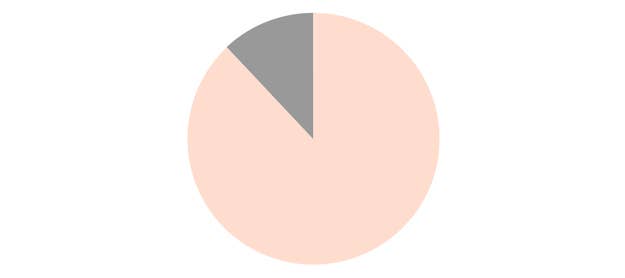
Tech startups live and die by their early adopters.
Beta testers do a lot more than find and report bugs. They offer feedback on the product, and tell the founders what works and what doesn't. Their insights can cause a company to change course early on before it's fully committed to a product direction. And when early users fall in love with the product and evangelize it among their peers, they create a virtuous cycle of demand that can mean the difference between a successful release and an uncomfortable post-launch investor meeting.
In addition, beta users of high-profile tech startups are often drawn from influential members of the founders' inner circles. These connections include venture capitalists, other founders, angel investors, and well-known bloggers, amplifying the reach of the startup even more when it opens its doors to the general public.
But for all their power, little is known about the demographics of these users (often called "alpha geeks") other than their tendency to adopt new technology before the rest of humanity. Where do they live? What do they look like? How closely do they resemble the users who will follow in their footsteps?
To find out, we dug into the user bases of three recently-launched publishing platforms: Svbtle, an invite-only blog publishing network; Medium, a minimalist publishing platform from the Twitter dudes (also currently invite only); and App.net, an open infrastructure-level version of Twitter (open to anyone, but charges $50 a year). The results paint a portrait of typical early-adopters: white, male, and (at least in the case of Medium) mostly influencers based in major tech hubs.
(Skip to the end, if you'd like to read more about the methodology, like how we determined "whiteness.")
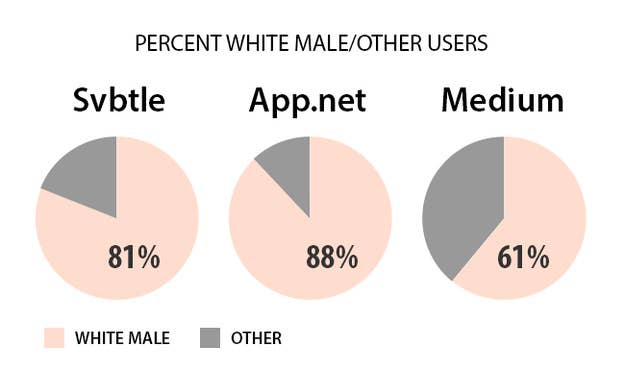
White Males vs. Everyone Else
The tech, startup, and venture capital scenes all have reputations for being both overwhelmingly white and male. Some argue that the industry suffers from a serious lack of diversity in investing and hiring decisions.
How white and male is the early-adopter crowd? As it turns out, quite. White males make up 81 percent of the users at Svbtle, 88 percent of users at App.net, and 61 percent of users at Medium. It appears that Medium is somewhat more diverse than the other two platforms. It's important to note, however, that Medium is the youngest of the three, and has the smallest pool of beta users as well, so the data is less statistically significant.
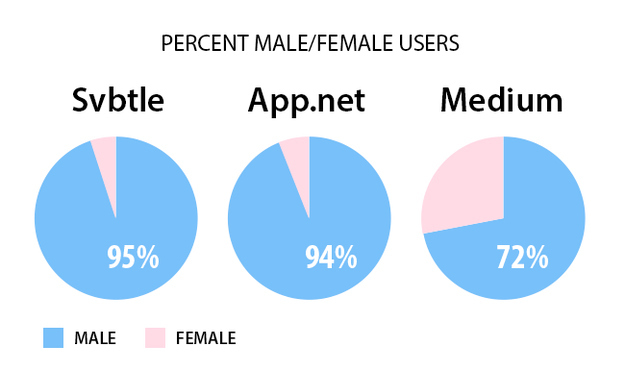
The Gender Divide
Sexism is rampant in tech. One of the reasons proposed is the overall lack of women in engineering and management roles at technology-driven startups.
What's the gender split among early adopters? Unfortunately, it's less a split and more a slice. 95 percent of users on Svbtle are men, while App.net is 94 percent male and Medium has a slightly more generous division at 72 percent. It seems the virtual ladies' room is still line-free.
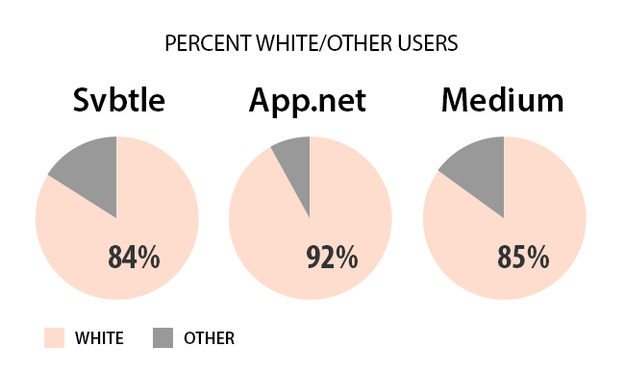
How White Are They, Really?
Drilling down into the racial divide, the graphs become more similar, and it's clear that early adopters are very, very white.
Svbtle's user base is 84 percent white overall, while App.net is the most white at 92 percent, and Medium falls between them at 85 percent. It seems that Medium's apparent diversity in the first chart is largely due to the number of women using the beta.
In other words, they're all whiter than Provo, Utah.

More on Medium: Locations and Influence on Twitter
In addition to the basic ethnographic demographic study detailed above, we did a secondary analysis of Medium's smaller pool of beta users. These users are identified by their Twitter handle, and with the help of the Twitter API we were able to compile a list of their locations for those whose bio included this information (12 of the 128 users, or 9.4 percent, left it blank).
It appears most of Medium's beta pool is based in major tech hubs. A full 64 percent of those who specified their location live in or around New York and the Bay Area.
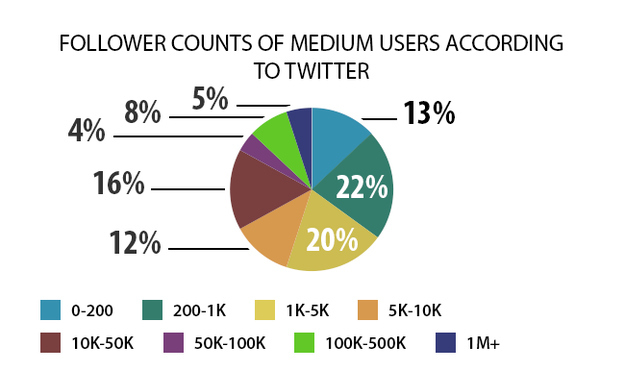
In addition to the lack of diversity in users' physical locations, the data also describes a disproportionately influential group. Slightly less than half of the users have upwards of 5,000 followers on Twitter, and 17 percent have over 50,000. Amazingly — even for a service created by two of the founders of Twitter — 5 percent of Medium's users (7 out of the 128 we discovered) of the beta pool have over a million followers. In addition, 11 percent have verified status on Twitter.
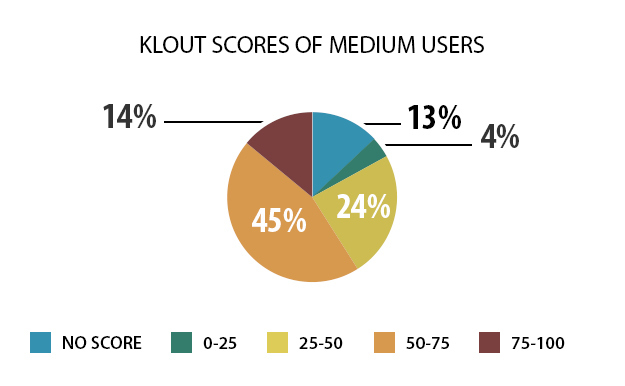
Of course, follower count is not the only measure of influence: we would be remiss without at least mentioning the users' Klout scores. The Klout data reinforces the trends shown above; 59 percent of the users have a Klout score of over 50, much higher than the average user's score, and 14 percent are in the ultra-high-influence bracket between 75 and 100. (The highest scores top out around 85.)
Conclusions
The data we gathered does nothing to dispell the stereotype of the white male-dominated tech industry. If anything, it confirms our suspicion that early adopters largly conform to it, and that the earliest adopters are often influential — highly influential, if Klout is to be believed — tech leaders based in and around New York and the Bay Area.
Be careful about reading too much into this, however. It might be easy to characterize these findings as supporting the theory that early adopters are frolicking in the fields of digital country clubs. But these are only three services among many; the reality is likely more complex. And with products like Svbtle and Medium — which are still small and invite-only — the backgrounds of the beta testers may just be a reflection of the founders' inner circles. That said, App.net, which is open to anyone (with $50 anyway) had the highest percentage of white male users.
What does this mean for startups? If a company's early adopters shape its product, but don't resemble the eventual user base, chances are their needs won't be the same as the "real" users. Founders should carefully account for this discrepency, or they might easily find themselves led astray by the whims of the alpha geeks. And in particular, founders at high-profile tech startups might want to ask themselves whether some more diversity in their beta testers could help bring the needs of the wider user base to light.
Methodology
"Whiteness" is defined, for the purposes of this study, as having a visibly white complexion as determined through the methods described below. White users are not necessarily North American, or Anglo-Saxon.
Figures do not include users for whom demographic information was unavailable. The percent of these users was statistically insignificant for Svbtle and Medium, but was considerably higher (about 32%) for App.net. Still, our identifiable sample size for App.net (668 accounts) is more than enough to provide a 95% confidence level, plus or minus 4%. Results could vary significantly from reality for App.net if a particular race or gender is more predisposed to avoid posting an identifiable profile image.
Svbtle: Blogs' URLs were collected from the featured list on Svbtle's homepage, as well as by reverse IP lookup and some clever googling. (Founder Dustin Curtis confirmed there is no full directory listed anywhere, "on purpose.") 105 blogs were found, each of which contained the author's full name and a brief biography in the sidebar. Users' gender and race were determined manually by examining images found on social networks, blogs, and Linkedin.
App.net: A full 24-hour sample of the global feed was generated by mercilessly scrolling down the page in Safari. HTML was then pulled from Safari's Web Inspector and scraped for posters' screen names. 980 unique users were identified. Profile images and full names were analyzed manually for gender and race.
Medium: Individual posts were discovered with a date- and site-specific google query which was run through the depreciated Google AJAX Search API for all days between July 31 and August 23, 2012. The API returns up to 64 results, hence the date hack, as the number of posts per day is still less than the result limit. 393 posts were scraped for the authors' Twitter screen names, which were then analyzed manually for gender and race, as well as location, follower count, verified status, and Klout scores, via the Twitter and Klout APIs.
All code used, and the final data sets and charts in Excel format, are available on github.
Ben Jackson is an iOS developer and writer living in Brooklyn, NY. He worked on news reader apps for the New York Times, and currently works on apps for Longform.
This study was the result of work done by the author with assistance from Allison McCann and Russell Brandom.
